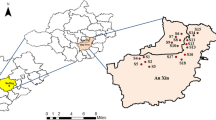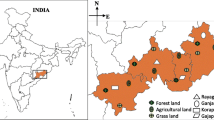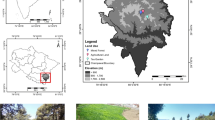Abstract
Soil characteristics influence earthworm population dynamics, species distribution and community structure. According in the present study an attempt was made to determine the soil physiochemical factors influencing earthworms of Kashmir valley with a view to improve the soil productivity by enhancing earthworm diversity under different pedoecosystems. Data collection on 15 soil parameters from 20 earthworm inhabiting sites revealed significant variation within and among the sites in soil temperature (F23, 19 = 148.83, 9.71; P < 0.05), moisture (F23, 19 = 16.91, 46.20; P < 0.05), pH (F19 = 47.21; P < 0.05), electrical conductivity (F23, 19 = 11.67, 87.13; P < 0.05), sodium (F23, 19 = 2.46, 211.25; P < 0.05), potassium (F19 = 22.91; P < 0.05), calcium (F19 = 15.90; P < 0.05), magnesium (F23, 19 = 1.76, 104.51; P < 0.05), organic carbon (F23, 19 = 64.60, 222.50; P < 0.05), organic nitrogen (F23, 19 = 4.59, 3.81; P < 0.05) and phosphorous (F23, 19 = 5.11, 137.87; P < 0.05). Aporrectodea caliginosa trapezoides and A. rosea rosea exhibited wide range of distribution whereas Octolasion cyaneum, A. c. trapezoides and A. parva showed restricted distribution. Hierarchical cluster analysis grouped 20 earthworm collection sites into three clusters—earthworm absent sites, low earthworm diversity sites and moderate earthworm diversity sites. Principal component analysis assisted from the data set of 20 sites, resulting into four latent factors accounting for 77.95 % of total variance, identified the factors affecting earthworm communities are mainly related to physical habitat factor, chemical factor, soil texture factor and growth factor, each accounting for 26.41, 20.16, 18.25 and 13.13 % of total variance respectively.



Similar content being viewed by others
References
Amador, J.A., and J.H. Görres. 2005. Role of the anecic earthworm Lumbricus terrestris L. in the distribution of plant residue nitrogen in a corn (Zea mays)-soil system. Applied Soil Ecology 30: 203–214.
Ammer, S., K. Weber, C. Abs, C. Ammer, and J. Prietzel. 2006. Factors influencing the distribution and abundance of earthworm communities in pure and converted Scots pine stands. Applied Soil Ecology 33: 10–21.
Anderson, J.M., and J.S.I. Ingram. 1993. Tropical soil biology and fertility: A handbook of methods, II ed. Wallingford: CAB International.
Bartlett, M., I. James, J. Harris, and K. Ritz. 2008. Earthworm community structure on five English golf courses. Applied Soil Ecology 39: 336–341.
Blanchart, E., and J.M. Julka. 1997. Influence of forest disturbance on earthworm (Oligochaeta) communities in the western ghats (South India). Soil Biology & Biochemistry 29: 303–306.
Bohlen, P.J., R.W. Parmelee, D.A. McCartney, and C.A. Edwards. 1997. Earthworm effects on carbon and nitrogen dynamics of surface litter in corn agroecosystems. Ecological Applications 7: 1341–1349.
Bohlen, P.J., R.W. Parmelee, M.F. Allen, and Q.M. Ketterings. 1999. Differential effects of earthworms on nitrogen cycling from various nitrogen-15-labeled substrates. Soil Science Society of American Journal 63: 882–890.
Briones, M.J.I., R. Mascato, and S. Mato. 1992. Relationships of earthworms with environmental factors studied by means of detrended canonical correspondence analysis. Acta Oecologica 13: 617–626.
Chan, K.Y., and I. Barchia. 2007. Soil compaction controls the abundance, biomass and distribution of earthworms in a single dairy farm in south-eastern Australia. Soil and Tillage Research 94: 75–82.
Chaudhuri, P.S., and A. Dey. 2012. Earthworm Communities in the Pineapple (Ananus comosus) and Mixed Fruit Plantations of West Tripura, India. Proceedings of Zoological Society. doi:10.1007/s12595-012-0047-y.
Chaudhuri, P.S., and G. Bhattacharjee. 1999. Earthworm resources of Tripura. Proceeding of National Academy of Sciences, India 69 (B) II: 159–170.
Chaudhuri, P.S., and S. Bhattacharjee. 2011. Reproductive biology of eight tropical earthworm species of rubber plantations in Tripura, India. Tropical Ecology 52(1): 49–60.
Chaudhuri, P.S., and S. Nath. 2011. Community structure of earthworms under rubber plantations and mixed forests in Tripura, India. Journal of Environmental Biology 32: 537–541.
Curry, J.P. 2004. Factors affecting the abundance of earthworms in soils. In Earthworm ecology, 3rd ed, ed. C.A. Edwards, 91–113. Boca Raton: St. Lucie Press.
Decaëns, T. 2010. Macroecological patterns in soil communities. Global Ecology and Biogeography 19: 287302.
Decaëns, T., F. Bureau, and P. Margerie. 2003. Earthworm communities in a wet agricultural landscape of the Seine Valley (Upper Normandy, France). Pedobiologia 47: 479–489.
Dlamini, T.C., and R.J. Haynes. 2004. Influence of agricultural land use on the size and composition of earthworm communities in northern KwaZulu-Natal, South Africa. Applied Soil Ecology 27: 77–88.
Dominguez, J., M. Aira, and M. Gomez-Brandon. 2009. The role of earthworms on the decomposition of organic matter and nutrient cycling. Ecosistemas 18(2): 20–31.
Edwards, C.A. 2004. Earthworm Ecology, II ed. Boca Raton: CRC Press.
Edwards, C.A., and P.J. Bohlen. 1996. Biology and ecology of earthworms. London: Chapman and Hall.
Eijsackers, H. 2011. Earthworms as colonizers of natural and cultivated soil environments. Applied Soil Ecology 50: 1–13.
Ernst, G., A. Müller, H. Göhler, and C. Emmerling. 2008. C and N turnover of fermented residues from biogas plants in soil in the presence of three different earthworm species (Lumbricus terrestris, Aporrectodea longa, Aporrectodea caliginosa). Soil Biology & Biochemistry 40: 1413–1420.
Ernst, G., and C. Emmerling. 2009. Impact of five different tillage systems on soil organic carbon content and the density, biomass, and community composition of earthworms after a ten year period. European Journal of Soil Biology 45: 247–251.
Fox, C.A. 2003. Characterizing soil biota in Canadian agroecosystems: state of knowledge in relation to soil organic matter. Canadian Journal of Soil Sciences 83: 245–257.
Fragoso, C., and P. Lavelle. 1992. Earthworm communities of tropical rain forests. Soil Biology & Biochemistry 24: 1397–1408.
Gee, G.W., and W. Bauder. 1986. Principle of the pipette method. In Agronomy: Methods of soil analysis. Part I: Physical and mineralogical methods, ed. A. Klute, 394–396. Madison: American Society of Agronomy.
Ghafoor, A., M. Hassan, and Z.H. Alvi. 2008. Biodiversity of earthworm species from various habitats of district Narowal, Pakistan. International Journal of Agricultural Biology 10: 681–684.
Gupta, P.K. 1999. Soil, plant, water and fertilizer analysis. Bikaner: Agro Botanica.
Haynes, R.J., C.S. Dominy, and M.H. Graham. 2003. Effect of agricultural land use on soil organic matter and the composition of earthworm communities in KwaZulu-Natal, South Africa. Agriculture Ecosystem and Environment 95: 453–464.
Huerta, E., J. Rodriguez-Olan, I. Evia-Castillo, E. Montejo-Meneses, M. Cruz-Mondragon, R. Garcia-Hernandez, and S. Uribe. 2007. Earthworms and soil properties in Tabasco, Mexico. European Journal of Soil Biology 43: 190–195.
Iordache, M., and I. Borza. 2010. Relation between chemical indices of soil and earthworm abundance under chemical fertilization. Plant and Soil Environment 56(9): 401–407.
Jackson, M.L. 1973. Soil chemical analysis. New Delhi: Prentice Hall of India Pvt. Ltd.
Jongmans, A.G., M.M. Pulleman, M. Balabane, F. Oort, and J.C.Y. Marinissen. 2003. Soil structure and characteristics of organic matter in two orchards differing in earthworm activity. Applied Soil Ecology 24: 219–232.
Joschko, M., C.A. Fox, P. Lentzsch, J. Kiesel, W. Hierold, S. Kruck, and J. Timmer. 2006. Spatial analysis of earthworm biodiversity at the regional scale. Agriculture Ecosystem and Environment 112: 367–380.
Joshi, N., and S. Aga. 2009. Diversity and distribution of earthworms in a subtropical forest ecosystem in Uttarakhand, India. The Natural History Journal Chulalongkorn University 9(1): 21–25.
Jouquet, P., T. Plumere, T.D. Thu, C. Rumpel, T.T. Duc, and D. Orange. 2010. The rehabilitation of tropical soils using compost and vermicompost is affected by the presence of endogeic earthworms. Applied Soil Ecology 46: 125–133.
Karaca, A., R. Kizilkaya, O.C. Turgay, and S.C. Cetin. 2010. Effects of earthworms on the availability and removal of heavy metals in soils. In Soil heavy metals, soil biology series 19, ed. I. Sherameti, and A. Varma, 369–388. Berlin: Springer.
Kizilkaya, R., A. Karaca, O.C. Turgay, and S.C. Cetin. 2011. Earthworm interactions with soil enzymes. In Biology of earthworms, ed. A. Karaca. Berlin: Springer.
Klo, C., J. Faber, G. Heijmans, J. Bodt, and A. Hout. 2007. Influence of clay content and acidity of soil on development of the earthworm Lumbricus rubellus and its population level consequences. Biology and Fertility of Soil 43: 549–556.
Lattin, J., D. Carroll, and P. Green. 2003. Analyzing multivariate data. New York: Duxbury.
Lavelle, P., C. Lattaud, D. Trigo, and I. Barois. 1995. Mutualism and biodiversity in soils. Plant and Soil 170: 23–33.
Lavelle, P., L. Brussaard, and P. Hendrix. 1999. Earthworm management in tropical agroecosystems. Wallingford: CAB International.
Laverack, M.S. 1963. The physiology of earthworms. Oxford: Pergamon Press.
Lee, K.E. 1985. Earthworms, their ecology and relationships with soils and land use. New York: Academic Press.
Liu, C.W., K.H. Lin, and Y.M. Kuo. 2003. Application of factor analysis in the assessment of groundwater quality in a Blackfoot disease area in Taiwan. Science of the Total Environment 313: 77–89.
Ll, H., X. Li, Z. Dou, J. Zhang, and C. Wang. 2012. Earthworm (Aporrectodea trapezoides)- mycorrhiza (Glomus intraradices) interaction and nitrogen and phosphorus uptake by maize. Biology and Fertility of Soils 48: 75–85.
Magurran, A.E. 2004. Measuring biological diversity. Oxford: Blackwell Publishing Ltd.
Mainoo, N.O.K., K. Joann, J.K. Whalen, and S. Barrington. 2008. Earthworm abundance related to soil physicochemical and microbial properties in Accra, Ghana. African Journal of Agricultural Research 3(3): 186–194.
Makeschin, F. 1997. Earthworms (Lumbricidae: Oligochaeta): important promoters of soil development and soil fertility. In Fauna in soil ecosystems: Recycling processes, nutrient fluxes and agricultural production, ed. G. Benckiser, 173–223. New York: Marcel Dekker.
Marichal, R., A.F. Martinez, C. Praxedesc, D. Ruiz, A.F. Carvajal, J. Oszwald, M. Hurtado, G.G. Brown, M. Grimaldi, T. Desjardins, M. Sarrazin, T. Decaëns, E. Velasquez, and P. Lavelle. 2010. Invasion of Pontoscolex corethrurus (Glossoscolecidae, Oligochaeta) in landscapes of the Amazonian deforestation arc. Applied Soil Ecology 46: 443–449.
Najar, I.A., and A.B. Khan. 2011. Earthworm communities of Kashmir Valley, India. Tropical Ecology 52(2): 151–162.
Najar, I.A., and A.B. Khan. 2013a. Management of fresh water weeds (macrophytes) by vermicomposting using Eisenia fetida. Environmental Science and Pollution Research. doi:10.1007/s11356-013-1687-9.
Najar, I.A., and A.B. Khan. 2013b. Effect of vermicompost on growth and productivity of tomato (Lycopersicon esculentum) under field conditions. Acta Biologica Malaysiana 2(1): 12–21.
Nuutinen, V., J. Pitkänen, E. Kuusela, T. Wibdom, and H. Lohilahti. 1998. Spatial variation of an earthworm community related to soil properties and yield in a grass-clover field. Applied Soil Ecology 8: 85–94.
Ouellet, G., D.R. Lapen, E. Topp, M. Sawada, and M. Edwards. 2008. A heuristic model to predict earthworm biomass in agroecosystems based on selected management and soil properties. Applied Soil Ecology 39: 35–45.
Ridvan, Kizilkaya R., A. Karaca, O.C. Turgay, and S.C. Cetin. 2011. Earthworm interactions with soil enzymes. In Biology of earthworms, ed. A. Karaca, 141–158. Berlin: Springer.
Sabrina, D.T., M.M. Hanafi, N.A.A. Azwady, and T.M.M. Mahmud. 2009. Earthworm populations and cast properties in the soils of oil palm plantations. Malaysian Journal of Soil Science 13: 29–42.
Salomé, C., C. Guenat, G. Bullinger-Weber, J.M. Gobata, and R.C.L. Bayon. 2011. Earthworm communities in alluvial forests: Influence of altitude, vegetation stages and soil parameters. Pedobiologia 54S: S89–S98.
Sanchez, E.G., B. Munoz, M.H. Garvin, J.B. Jesus, and D.J.D. Cosin. 1997. Ecological preferences of some earthworm species in southwest Spain. Soil Biology & Biochemistry 29(3/4): 316–331.
Simard, R.R. 1993. Ammonium acetate extractable elements. In Soil sampling and method of analysis, ed. S. Carter, and R. Martin. Florida: Lewis Publishers.
Sinha, B., T. Bhadauria, P.S. Ramakrishnan, K.G. Saxena, and R.K. Maikhuri. 2003. Impact of landscape modification on earthworm diversity and abundance in the Hariyali sacred landscape, Garhwal Himalaya. Pedobiologia 47: 357–370.
Smith, R.G., C.P. McSwiney, A.S. Grandy, P. Suwanwaree, R.M. Snider, and G.P. Robertson. 2008. Diversity and abundance of earthworms across an agricultural land-use intensity gradient. Soil and Tillage Research 100: 83–88.
Speratti, A.B., J.K. Whalen, and P. Rochette. 2007. Earthworm influence on carbon dioxide and nitrous oxide fluxes from an unfertilized corn agroecosystem. Biology and Fertility of Soils 44: 405–409.
Spurgeon, D.J., and S.P. Hopkin. 1999. Seasonal variation in the abundance, biomass and biodiversity of earthworms in soils contaminated with metal emissions from a primary smelting works. Journal of Applied Ecology 36: 173–183.
Tiunov, A.V., M. Bonkowski, J. Alphei, and S. Scheu. 2001. Microflora, Protozoa and Nematoda in Lumbricus terrestris burrow walls: a laboratory experiment. Pedobiologia 45: 46–60.
Verma, D., and Shweta. 2011. Earthworm resources of Western Himalayan region, India. International Journal of Soil Science 6(2): 124–133.
Walkley, A., and I.A. Black. 1934. An examination of the Degtjareff method for determining soil organic matter, and a proposed modification of the chromic acid titration method. Soil Science 34: 29–38.
Whalen, J.K. 2004. Spatial and temporal distribution of earthworm patches in corn field, hayfield and forest systems of southwestern Quebec, Canada. Applied Soil Ecology 27: 143–151.
Zar, J.H. 2009. Biostatistical analysis, V ed. Englewood Cliffs: Prentice Hall.
Zorn, M.I., C.A.M.V. Gestel, and H. Eijsackers. 2005. Species-specific earthworm population responses in relation to flooding dynamics in a Dutch floodplain soil. Pedobiologia 49: 189–198.
Acknowledgments
Authors express thanks to Dr. J. M. Julka and Dr. R. Paliwal of Zoological Survey of India, for taxonomic identification of the earthworm species and Dr. Abdul Hai, Head, Hydrobiology Research Laboratory, Kashmir for providing laboratory facilities.
Author information
Authors and Affiliations
Corresponding author
Rights and permissions
About this article
Cite this article
Najar, I.A., Khan, A.B. Factors Affecting Distribution of Earthworms in Kashmir Valley: A Multivariate Statistical Approach. Proc Zool Soc 67, 126–135 (2014). https://doi.org/10.1007/s12595-013-0081-4
Received:
Revised:
Accepted:
Published:
Issue Date:
DOI: https://doi.org/10.1007/s12595-013-0081-4




